
The RF-7 III sports a new tweeter design: It still resides within the familiar Tractrix square horn, but the sound is generated by a larger, 1.75-inch titanium diaphragm compression driver. It is nearly twice as large as the previous one-inch drivers. Klipsch claims this new arrangement improves high-frequencies thanks to improved sound pressure linearity. But take a closer look at the horn itself and you will see another change. The outer portion of the horn is square, but as its sides dive inward toward the driver, they meet a circular throat, instead of the usual square throat of earlier Tractrix horns. The benefit to this — a design Klipsch calls a “90-degree by 90-degree Tractrix horn” — is further improved high-frequency response and extension.
Also new to the floor-standing speaker is a dual-chamber design for the low-frequency drivers — each 10-inch driver occupies its own discrete cavity and has its own rear-firing port. The ports themselves also get a makeover, and now use the same Tractrix-based geometry as the front-firing horn.

The RC-64 III center channel shares most of the RF-7’s new features, including the redesigned horn, and larger high-frequency driver, but also packs a few of its own upgrades. Its four low-end drivers are the largest available in a Klipsch center channel speaker, at 6.5 inches, and they are managed by a new network crossover design. It attenuates some of the low-end coming from the outermost drivers during high frequencies so that listeners sitting off to the sides still hear the same audio balance as someone sitting dead-center — a plus for home theater configurations that are wider than they are deep.
Both new reference speakers feature magnetically latched, removable grilles, and come in three furniture-grade wood veneer options, including black ash, cherry, and walnut.



